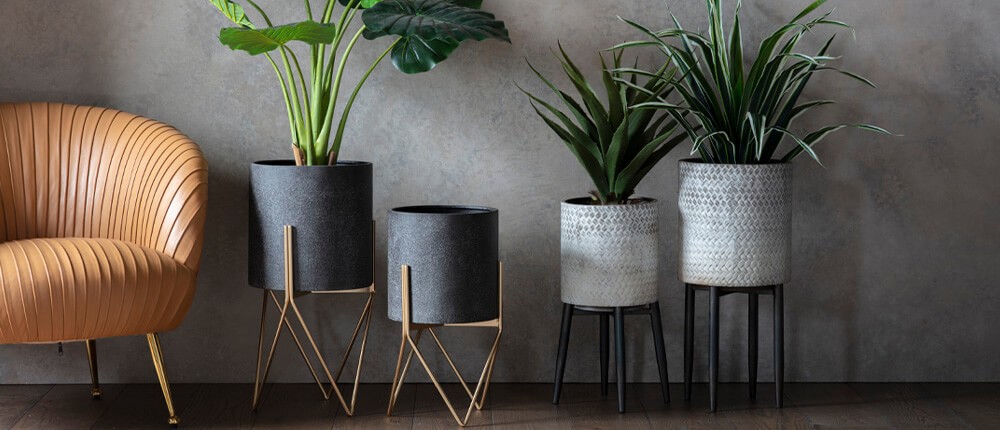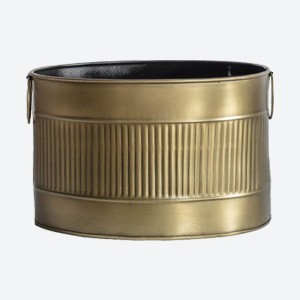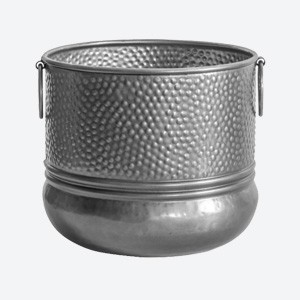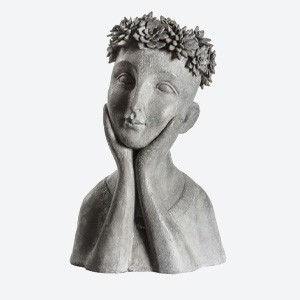When it comes to plants, there's a lot to be said for selecting the right pot. Key factors to consider include what plant pot materials will best suit your plant, as well as ensuring the planter is in-keeping with your interior or exterior style. We're keep things simple with a quick round up of the pros and cons of the best plant pot materials, while also pinpointing some of our best-selling styles, ensuring your plant pots are as fashionable as they are functional.
Which Plant Pots Are Best?
A Guide to Selecting the Best Plant Pot Materials
There really is no right or wrong when it comes to choosing a plant pot. However, depending on the needs of the plant, different plant pot materials offer different properties.

Ceramic Planters
Glazed ceramic plant pots are popular for their diverse range of styles, patterns and designs. Plus, they are brilliant for a variety of flowers and plants. Many designs are large enough to be used as a decorative planter to disguise a less stylish plastic pot.
Pros: Lots of Styles, Good for Retaining Moisture
Not only does the glazed finish of ceramic look appealing, but it is functional too. Ceramic planters are great for retaining water, making them ideal for moisture-loving plants like ferns. The biggest draw of ceramic plant pots is most certainly the vast selection of styles, offering a multitude of colours and designs for every home and garden.
Cons: Heavy, Often No Drainage Holes
Ceramic plant pots can be heavy. If you want planters that you can move around easily, it might be worth considering a lighter option such as plastic instead. They also break easily if dropped. The glazed finish of ceramic can also be compromised over prolonged use outdoors, with cracks and chips appearing as temperatures change. Another disadvantage of ceramic planters is drainage holes. Many don't have any drainage holes, meaning that you may have to make your own if your plant doesn't thrive well when sat in stagnant water.
Shop Ceramic Planters

Metal Plant Pots
Metal planters are great for creating a modern or industrial look in your home or garden. Iron, stainless steel and aluminium planters all have their own advantages and characteristics.
Pros: Strong, Durable
The main draw of metal as a plant pot material is not only style but durability. Metal planters are strong and long-lasting. If being used outdoors, some types of metal such as iron and stainless steel will wear over time due to changing weather conditions. This creates a unique, natural patina that adds an aged appeal to garden spaces. If looking for a DIY project, metal planters can be created from a range of re-purposed items such as troughs and saucepans for unique, vintage look.
Cons: Rusting, Sunburn
While the wearing of outdoor metal planters is seen as a feature to some, it may be less desirable to others. Keep your planters rust-free by using them indoors instead. Alternatively, choose an aluminium outdoor planter or a plant pot with a powder-coating to prevent rust. The other consideration with metal plant pots is sunburn. If placed in direct sunlight, the planters can become hot which will not only dry out the soil more quickly, but risks burning the plant and its roots. Adding a lining such as fabric, plastic with holes in or moss to the pot before planting reduces the risk of burning the roots.
Shop Metal Planters

Stone Plant Pots
Stone plant pots are very diverse. From concrete and limestone to marble and granite, there are a range of stoneware planters to choose from, each bringing a different look to your home or garden.
Pros: Long-lasting, Heavy
Stone planters are great for both indoor and outdoor use. They are extremely durable and long-lasting. Plus, this plant pot material is naturally heavy so it's perfect for outdoor settings that might be subjected to strong winds. Stone plant pots are generally more limited to neutral colours which makes a beautiful backdrop for green foliage and colourful flowers.
Cons: Absorbs Nutrients, Heavy
Some stone materials are not best suited to all plant types. Concrete, for example, naturally absorbs nutrients, making soil more alkaline. This is ideal for plants like succulents and cacti that thrive in alkaline soil. For plants that like more acidic soil, concrete planters need to be applied with a sealing solution in order for them to grown and thrive. The weight of stone planters can also be problematic if you want to move them around your home or garden.
Shop Stone Planters

Terracotta Planters
Terracotta plant pots are characterised by their warm, reddish-brown colour. They are usually unglazed inside and out. If looked after, they can last for a number years.
Pros: Porous, Good for Drainage
Terracotta planters are popular with gardeners and homeowners because - quite simply - they look nice! More technically, this plant pot material is porous. This means that tiny holes in the terracotta allow water and air to flow through to the roots, as well as drain out. For this reason, terracotta plant pots are ideal for plants like cacti and succulents that require really good drainage. There are also range of price points on the market, offering terracotta for every budget.
Cons: Heavy
The porous nature of terracotta makes it unsuitable for plants that need lots of water. You may find yourself watering excessively when a pot that provides less drainage like glazed ceramic or plastic will be much better suited. Like ceramic, terracotta planters will shatter if dropped and will not withstand cold and frosty conditions over time. Consider bringing them indoors over the winter months to lengthen their lifespan. Due to their weight, terracotta plant pots can be difficult to move, especially so when filled with soil. For a lightweight, terracotta look, choose a reddish-brown coloured plastic plant pot instead.

Plastic Planters
Don't be put off by the negative connotations of plastic plant pots. If looked after, they can be used time and time again for a range of plants and are actually one of the best materials for many varieties.
Pros: Lightweight, Good for Retaining Moisture
Plastic plant containers are lightweight and affordable. They are one of the best options for retaining moisture, ensuring plants are kept well hydrated. They are also fairly resilient to damage. If dropped, they are likely to remain useable and intact, unlike a stone or ceramic planter. One of the best things about plastic as a plant pot material is its wide variety of colour options. You can even buy plastic pots in reddish-brown colours that resemble terracotta.
Cons: Not Hard-wearing
While the lightweight nature of plastic is a huge advantage, it is far less hard-wearing than other plant pot materials. Over time, it can become brittle under harsh hot and cold weather conditions causing the colour to fade and cracks to form. Logically, the quality of plastic planters lasts much longer when placed indoors. Place a plastic pot inside a decorative planter to match your interior if the colour or style of the plastic isn't in-keeping with your home.
Plant Pot Styles
For Natural & Artificial Plants
Whatever material your plant pot is made from, there are a multitude of beautiful planter styles to choose from. Below, we've pinpointed some of our favourites, but you can shop our full collection of planters here. If your focus is more on planter style rather than suitability, why not use artificial flowers in your plant pots? No need to worry about watering and they will look good all year round!

Plant Stands
More than simply a pot, plant stands are designed to be a feature of your space, especially so in an indoor setting. These tall planters sit on legs that add height to your plants. They can be styled together amongst various sizes to create a tiered effect, adding depth and dimension to a room. Better still, with metal, gold, marble effect designs and many more, plant stands offer different styles for every home. Use with green leafy plants in the corner of a contemporary apartment or studio space space to add fresh colour and chic style.
Animal Plant Pots
From safari animals to birds, animal planters add character and personality to your home. They also make fantastic gifts for those with a particular favourite animal in mind. For an eclectic feel, select animal-shaped plant pots to house succulents or tall grass. Part planter, part ornament, these pots become a talking point of a room. For something more understated, look for more traditionally shaped plant pots detailed with animal prints.
Outdoor Planters
Although many may not realise it, outdoor plant pots can be both hardy and stylish. And while plastic, stone and terracotta options are popular, there are a range of outdoor metal planters available too. From flowers to foliage, outdoor planters come in a range of styles and sizes to make your exterior as unique in style as your interior. Try placing a metal planter with an antique brass, silver or copper finish under your porch or on your patio to create a connection with the finishes of your interior, uniting home and garden.
Patterned Plant Pots
Like animal planters, patterned plant pots are a reflection of your unique home style. Patterned planters work well with any plant however we'd suggest sticking to one colour to avoid a pattern clash. Terracotta pots with ceramic tile detailing by Parlane add a traditional country garden feel to your home. Meanwhile, subtly patterned grey and white plant pots are the perfect complement to a contemporary or minimalist space. To match a modern or bohemian style home, plant a green cacti in a geometric patterned pot.
Plant Pots with Faces
Part ornament, part planter, face and head-shaped flower pots come in a variety of styles. From ornate busts to half face planters, these plant pots will become ornamental features of your home. Quirky and unusual, some plant pots with faces are more abstract, while others are intricate sculptures with beautiful levels of detail. They are often neutral in colour, making them perfect for housing a bloom of vibrantly coloured flowers. Place in windowsills in a kitchen, dining or utility space to add interest.
Plant Pot Materials
Before you choose a plant pot, consider what is it you want from it. Are you looking to safely house a growing plant? Or do you want a planter of a particular style for your home? If design is your priority, make life simple by choosing a planter of your liking in any material and style with artificial flowers for a look that is as good in autumn as it is in spring - without the need for regular watering or maintenance. However, if what's important is the plant in the pot itself, then check the requirements of your growing plant carefully and use our tips above to choose a planter that will help your plant thrive!




















